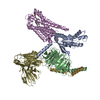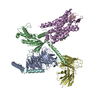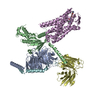登録情報 データベース : PDB / ID : 7y26タイトル Cryo-EM structure of the octreotide-bound SSTR2-miniGq-scFv16 complex (Guanine nucleotide-binding protein ...) x 2 Engineered Guanine nucleotide-binding protein G(q) subunit alpha Octreotide Somatostatin receptor type 2 single Fab chain (svFv16) キーワード / / / 機能・相同性 分子機能 ドメイン・相同性 構成要素
/ / / / / / / / / / / / / / / / / / / / / / / / / / / / / / / / / / / / / / / / / / / / / / / / / / / / / / / / / / / / / / / / / / / / / / / / / / / / / / / / / / / / / / / / / / / / / / / / / / / / / / / / / / / / / / / / / / / / / / / / / 生物種 Homo sapiens (ヒト)手法 / / / 解像度 : 3.3 Å データ登録者 Chen, S. / Zheng, S. 資金援助 組織 認可番号 国 Ministry of Science and Technology (MoST, China)
ジャーナル : Nat Chem Biol / 年 : 2023タイトル : Molecular basis for the selective G protein signaling of somatostatin receptors.著者 : Sijia Chen / Xiao Teng / Sanduo Zheng / 要旨 : G protein-coupled receptors (GPCRs) modulate every aspect of physiological functions mainly through activating heterotrimeric G proteins. A majority of GPCRs promiscuously couple to multiple G ... G protein-coupled receptors (GPCRs) modulate every aspect of physiological functions mainly through activating heterotrimeric G proteins. A majority of GPCRs promiscuously couple to multiple G protein subtypes. Here we validate that in addition to the well-known G pathway, somatostatin receptor 2 and 5 (SSTR2 and SSTR5) couple to the G pathway and show that smaller ligands preferentially activate the G pathway. We further determined cryo-electron microscopy structures of the SSTR2‒G and SSTR2‒G complexes bound to octreotide and SST-14. Structural and functional analysis revealed that G protein selectivity of SSTRs is not only determined by structural elements in the receptor-G protein interface, but also by the conformation of the agonist-binding pocket. Accordingly, smaller ligands fail to stabilize a broader agonist-binding pocket of SSTRs that is required for efficient G coupling but not G coupling. Our studies facilitate the design of drugs with selective G protein signaling to improve therapeutic efficacy. 履歴 登録 2022年6月9日 登録サイト / 処理サイト 改定 1.0 2022年10月19日 Provider / タイプ 改定 1.1 2023年2月15日 Group / カテゴリ / citation_authorItem _citation.journal_volume / _citation.page_first ... _citation.journal_volume / _citation.page_first / _citation.page_last / _citation.year / _citation_author.identifier_ORCID
すべて表示 表示を減らす
 データを開く
データを開く 基本情報
基本情報 要素
要素 キーワード
キーワード STRUCTURAL PROTEIN (タンパク質) /
STRUCTURAL PROTEIN (タンパク質) /  GPCR (Gタンパク質共役受容体) /
GPCR (Gタンパク質共役受容体) /  G protein (Gタンパク質) / biased ligand
G protein (Gタンパク質) / biased ligand 機能・相同性情報
機能・相同性情報 somatostatin receptor activity /
somatostatin receptor activity /  蠕動 /
蠕動 /  neuropeptide binding / cellular response to glucocorticoid stimulus / response to starvation / G protein-coupled receptor signaling pathway, coupled to cyclic nucleotide second messenger / neuropeptide signaling pathway / forebrain development / adenylate cyclase-inhibiting G protein-coupled receptor signaling pathway / Peptide ligand-binding receptors ...
neuropeptide binding / cellular response to glucocorticoid stimulus / response to starvation / G protein-coupled receptor signaling pathway, coupled to cyclic nucleotide second messenger / neuropeptide signaling pathway / forebrain development / adenylate cyclase-inhibiting G protein-coupled receptor signaling pathway / Peptide ligand-binding receptors ... somatostatin receptor activity /
somatostatin receptor activity /  蠕動 /
蠕動 /  neuropeptide binding / cellular response to glucocorticoid stimulus / response to starvation / G protein-coupled receptor signaling pathway, coupled to cyclic nucleotide second messenger / neuropeptide signaling pathway / forebrain development / adenylate cyclase-inhibiting G protein-coupled receptor signaling pathway / Peptide ligand-binding receptors / cerebellum development / cellular response to estradiol stimulus /
neuropeptide binding / cellular response to glucocorticoid stimulus / response to starvation / G protein-coupled receptor signaling pathway, coupled to cyclic nucleotide second messenger / neuropeptide signaling pathway / forebrain development / adenylate cyclase-inhibiting G protein-coupled receptor signaling pathway / Peptide ligand-binding receptors / cerebellum development / cellular response to estradiol stimulus /  PDZ domain binding / Olfactory Signaling Pathway / Activation of the phototransduction cascade / G beta:gamma signalling through PLC beta / Presynaptic function of Kainate receptors / Thromboxane signalling through TP receptor / G-protein activation / G protein-coupled acetylcholine receptor signaling pathway / Activation of G protein gated Potassium channels / Inhibition of voltage gated Ca2+ channels via Gbeta/gamma subunits / Prostacyclin signalling through prostacyclin receptor / Glucagon signaling in metabolic regulation / G beta:gamma signalling through CDC42 / ADP signalling through P2Y purinoceptor 12 / G beta:gamma signalling through BTK / Synthesis, secretion, and inactivation of Glucagon-like Peptide-1 (GLP-1) / Sensory perception of sweet, bitter, and umami (glutamate) taste / photoreceptor disc membrane / Adrenaline,noradrenaline inhibits insulin secretion / Glucagon-type ligand receptors / Vasopressin regulates renal water homeostasis via Aquaporins / G alpha (z) signalling events / cellular response to catecholamine stimulus / Glucagon-like Peptide-1 (GLP1) regulates insulin secretion / ADORA2B mediated anti-inflammatory cytokines production / sensory perception of taste / ADP signalling through P2Y purinoceptor 1 / adenylate cyclase-activating dopamine receptor signaling pathway / G beta:gamma signalling through PI3Kgamma / cellular response to prostaglandin E stimulus / Cooperation of PDCL (PhLP1) and TRiC/CCT in G-protein beta folding / GPER1 signaling / G-protein beta-subunit binding / Inactivation, recovery and regulation of the phototransduction cascade /
PDZ domain binding / Olfactory Signaling Pathway / Activation of the phototransduction cascade / G beta:gamma signalling through PLC beta / Presynaptic function of Kainate receptors / Thromboxane signalling through TP receptor / G-protein activation / G protein-coupled acetylcholine receptor signaling pathway / Activation of G protein gated Potassium channels / Inhibition of voltage gated Ca2+ channels via Gbeta/gamma subunits / Prostacyclin signalling through prostacyclin receptor / Glucagon signaling in metabolic regulation / G beta:gamma signalling through CDC42 / ADP signalling through P2Y purinoceptor 12 / G beta:gamma signalling through BTK / Synthesis, secretion, and inactivation of Glucagon-like Peptide-1 (GLP-1) / Sensory perception of sweet, bitter, and umami (glutamate) taste / photoreceptor disc membrane / Adrenaline,noradrenaline inhibits insulin secretion / Glucagon-type ligand receptors / Vasopressin regulates renal water homeostasis via Aquaporins / G alpha (z) signalling events / cellular response to catecholamine stimulus / Glucagon-like Peptide-1 (GLP1) regulates insulin secretion / ADORA2B mediated anti-inflammatory cytokines production / sensory perception of taste / ADP signalling through P2Y purinoceptor 1 / adenylate cyclase-activating dopamine receptor signaling pathway / G beta:gamma signalling through PI3Kgamma / cellular response to prostaglandin E stimulus / Cooperation of PDCL (PhLP1) and TRiC/CCT in G-protein beta folding / GPER1 signaling / G-protein beta-subunit binding / Inactivation, recovery and regulation of the phototransduction cascade /  heterotrimeric G-protein complex / G alpha (12/13) signalling events /
heterotrimeric G-protein complex / G alpha (12/13) signalling events /  extracellular vesicle / signaling receptor complex adaptor activity / Thrombin signalling through proteinase activated receptors (PARs) / retina development in camera-type eye /
extracellular vesicle / signaling receptor complex adaptor activity / Thrombin signalling through proteinase activated receptors (PARs) / retina development in camera-type eye /  GTPase binding / phospholipase C-activating G protein-coupled receptor signaling pathway / Ca2+ pathway / G alpha (i) signalling events / fibroblast proliferation / G alpha (s) signalling events /
GTPase binding / phospholipase C-activating G protein-coupled receptor signaling pathway / Ca2+ pathway / G alpha (i) signalling events / fibroblast proliferation / G alpha (s) signalling events /  精子形成 / G alpha (q) signalling events / cell population proliferation / Ras protein signal transduction / Extra-nuclear estrogen signaling / neuron projection / G protein-coupled receptor signaling pathway / lysosomal membrane / negative regulation of cell population proliferation /
精子形成 / G alpha (q) signalling events / cell population proliferation / Ras protein signal transduction / Extra-nuclear estrogen signaling / neuron projection / G protein-coupled receptor signaling pathway / lysosomal membrane / negative regulation of cell population proliferation /  GTPase activity /
GTPase activity /  シナプス / protein-containing complex binding /
シナプス / protein-containing complex binding /  シグナル伝達 / extracellular exosome /
シグナル伝達 / extracellular exosome /  生体膜 /
生体膜 /  細胞膜 /
細胞膜 /  細胞質基質 /
細胞質基質 /  細胞質
細胞質
 Homo sapiens (ヒト)
Homo sapiens (ヒト) 電子顕微鏡法 /
電子顕微鏡法 /  単粒子再構成法 /
単粒子再構成法 /  クライオ電子顕微鏡法 / 解像度: 3.3 Å
クライオ電子顕微鏡法 / 解像度: 3.3 Å  データ登録者
データ登録者 中国, 1件
中国, 1件  引用
引用 ジャーナル: Nat Chem Biol / 年: 2023
ジャーナル: Nat Chem Biol / 年: 2023
 構造の表示
構造の表示 Molmil
Molmil Jmol/JSmol
Jmol/JSmol ダウンロードとリンク
ダウンロードとリンク ダウンロード
ダウンロード 7y26.cif.gz
7y26.cif.gz PDBx/mmCIF形式
PDBx/mmCIF形式 pdb7y26.ent.gz
pdb7y26.ent.gz PDB形式
PDB形式 7y26.json.gz
7y26.json.gz PDBx/mmJSON形式
PDBx/mmJSON形式 その他のダウンロード
その他のダウンロード https://data.pdbj.org/pub/pdb/validation_reports/y2/7y26
https://data.pdbj.org/pub/pdb/validation_reports/y2/7y26 ftp://data.pdbj.org/pub/pdb/validation_reports/y2/7y26
ftp://data.pdbj.org/pub/pdb/validation_reports/y2/7y26


 F&H 検索
F&H 検索 リンク
リンク 集合体
集合体
 要素
要素
 Homo sapiens (ヒト) / 遺伝子: GNB1 / 発現宿主:
Homo sapiens (ヒト) / 遺伝子: GNB1 / 発現宿主: 
 Trichoplusia ni (イラクサキンウワバ) / 参照: UniProt: P62873
Trichoplusia ni (イラクサキンウワバ) / 参照: UniProt: P62873
 Homo sapiens (ヒト) / 遺伝子: GNG2 / 発現宿主:
Homo sapiens (ヒト) / 遺伝子: GNG2 / 発現宿主: 
 Trichoplusia ni (イラクサキンウワバ) / 参照: UniProt: P59768
Trichoplusia ni (イラクサキンウワバ) / 参照: UniProt: P59768
 Homo sapiens (ヒト) / 細胞株 (発現宿主): HEK293 / 発現宿主:
Homo sapiens (ヒト) / 細胞株 (発現宿主): HEK293 / 発現宿主: 
 Homo sapiens (ヒト)
Homo sapiens (ヒト)
 Homo sapiens (ヒト) / 遺伝子: SSTR2 / 細胞株 (発現宿主): HEK293 / 発現宿主:
Homo sapiens (ヒト) / 遺伝子: SSTR2 / 細胞株 (発現宿主): HEK293 / 発現宿主: 
 Homo sapiens (ヒト) / 参照: UniProt: P30874
Homo sapiens (ヒト) / 参照: UniProt: P30874 オクトレオチド
オクトレオチド
 Homo sapiens (ヒト)
Homo sapiens (ヒト)
 Homo sapiens (ヒト) / 細胞株 (発現宿主): HEK293 / 発現宿主:
Homo sapiens (ヒト) / 細胞株 (発現宿主): HEK293 / 発現宿主: 
 Homo sapiens (ヒト)
Homo sapiens (ヒト) 電子顕微鏡法
電子顕微鏡法 単粒子再構成法
単粒子再構成法 試料調製
試料調製 : NO / 凍結
: NO / 凍結 : YES
: YES
 電子顕微鏡撮影
電子顕微鏡撮影
 :
:  FIELD EMISSION GUN / 加速電圧: 300 kV / 照射モード: FLOOD BEAM
FIELD EMISSION GUN / 加速電圧: 300 kV / 照射モード: FLOOD BEAM Bright-field microscopy / 最大 デフォーカス(公称値): 5000 nm / 最小 デフォーカス(公称値): 1000 nm
Bright-field microscopy / 最大 デフォーカス(公称値): 5000 nm / 最小 デフォーカス(公称値): 1000 nm 解析
解析

 ムービー
ムービー コントローラー
コントローラー





 PDBj
PDBj
























